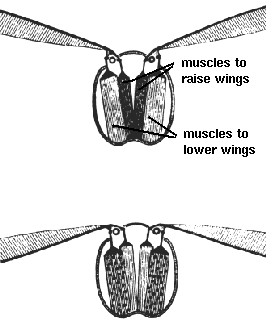 The Evolution of Flight
The Evolution of Flight
The Flight Muscles
There are two basic systems of muscles for flapping the wings: direct and
indirect. The descriptions which follow are greatly simplified, but the underlying
mechanism presented is employed by insects. There are many complications due to the large number
of muscles involved in flapping and twisting the wings and the nature of the attachment of the wings to
the thorax.
The Direct Muscle System
As the name implies, the muscles in this system are directly attached to the wings. The figure shows
a schematic cross-section of a thorax. The small circles are hinges where the wings are attached to
the top of the thorax (the tergum). In reality, these joints can rotate out of
 the plane of the diagram, but such motions do not need to be considered here. The direct musculature
has a pair of muscles for the up-stroke (top of diagram) and one for the down-stroke (bottom of diagram).
The contracting muscles have a darker shade. When the inner muscles contract, the wings rotate about
their hinges and flap upward. When the outer muscles contract, the wings are pulled downward again.
the plane of the diagram, but such motions do not need to be considered here. The direct musculature
has a pair of muscles for the up-stroke (top of diagram) and one for the down-stroke (bottom of diagram).
The contracting muscles have a darker shade. When the inner muscles contract, the wings rotate about
their hinges and flap upward. When the outer muscles contract, the wings are pulled downward again.
The disadvantages in this musculature are that the insect's brain must instruct the flight muscles with
each wingbeat to contract and to relax and that the wings, working completely independently of one another,
must be perfectly synchronized by the brain if the insect is not to crash. Also, insects employing this
muscle system must have low wingbeat frequencies because of the coordination of the signals from the brain.
The locust uses a direct musculature and exhibits notoriously clumsy-looking flight.

 The Evolution of Flight...3, March 1996
The Evolution of Flight...3, March 1996
 the plane of the diagram, but such motions do not need to be considered here. The direct musculature
has a pair of muscles for the up-stroke (top of diagram) and one for the down-stroke (bottom of diagram).
The contracting muscles have a darker shade. When the inner muscles contract, the wings rotate about
their hinges and flap upward. When the outer muscles contract, the wings are pulled downward again.
the plane of the diagram, but such motions do not need to be considered here. The direct musculature
has a pair of muscles for the up-stroke (top of diagram) and one for the down-stroke (bottom of diagram).
The contracting muscles have a darker shade. When the inner muscles contract, the wings rotate about
their hinges and flap upward. When the outer muscles contract, the wings are pulled downward again.
 The Evolution of Flight
The Evolution of Flight
 The Evolution of Flight...3, March 1996
The Evolution of Flight...3, March 1996